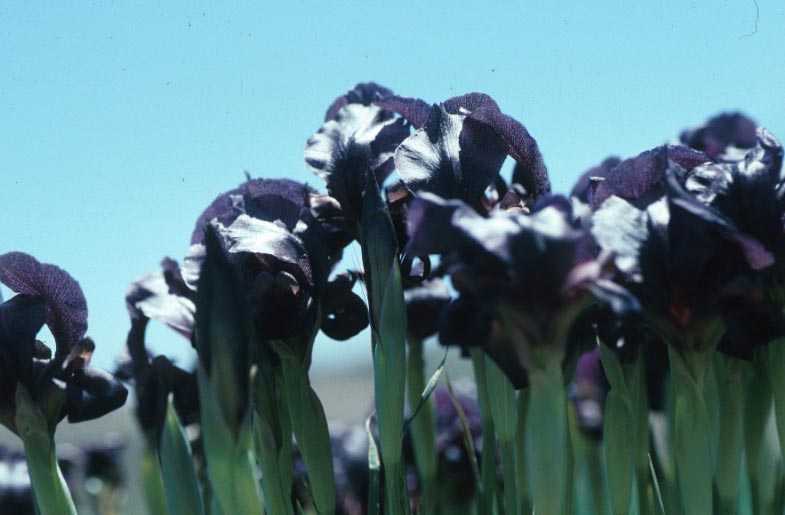

Few wild flowers are as familiar to Jordanians as the black iris. It is the only wild flower on the nation's currency, gracing the twenty dinar note. This is the time that the black irises are flowering and it is a good year to see them.
To an American or European a black iris is an oxymoron, it doesn't make sense. Garden irises in that part of the world reflect the Greek meaning of iris, rainbow, with a diversity of colors. Many are blue or purple; yellow colors can also be found. To have a black iris seems mysterious and strange.
Is it really black? I have examined hundreds of plants in the past few weeks and find a gradation of colors from purplish to black. A student of irises and a leading authority on the flora of Jordan, my colleague Professor Dawud Al-Eisawi, has collected variants and has them growing on the University of Jordan campus. Some of these are a delicate purple-black in color.
Two black irises are widespread in Jordan. One has the appropriate Latin name of Iris nigricans (literally, black iris). It is found roughly from Karak north and has smaller leaves and flowering stems than its southern cousin. The other is Iris petreana (Petra iris) found south of Kerak . It usually has larger leaves and stems. Superficially, the two species appear similar to me. Whatever the name, both are beautiful.
Take a closer look at the flower and you will see that it is a marvel of engineering. Locate the six petals, three are drooping and three are upright. Upright petals, or standards, help advertise the flower. The drooping petals, technically known as falls, have a band of colored hairs, the beard. Just above the beard is a single, large stamen, the male part of the flower. This stamen is the middle of a sandwich formed by the fall and the stigma. In most flowers the stigma, part of the female component of the flower, is long and narrow. In the iris it looks like a petal but has two lobes on the upper surface to receive the male cells, the pollen. Remember that the purpose of the flower is reproduction. Its beauty is very functional.
A nectar gathering or pollen gathering insect must push the stigma and petal apart to get to a nectar at the base of the flower or to reach a stamen. In visiting more than one flower, the insect is likely to transfer pollen from the stamen of one flower to the stigma of another. As the insect approaches the black iris, it perceives three flowers. Each sandwich of fall, stamen, and stigma functions as separate pollination units. Most iris pollinators are large bodied insects.
Where can you find black irises? This is a good year to look. Close to Amman, along the road from the desert highway to Medaba, is a nice stand of perhaps thirty plants on the south side of the road about midway between Medaba and the highway. If you take the road from the Desert Highway to Dibhan, you will see a lot of black irises along the road. Along the road from the village of Shoubak to Petra are numerous black irises. In late April, several spectacular plants were conspicuous 10 km south of Shoubak.
My favorite site is the road from Jerash to Mafraq, about eleven miles east of the turnoff to Mafraq. Get ready for a carnival of color! In this one site were scores of black irises, vestiges of red anemones, numerous poppies, brilliant yellow and orange daisies and in a nearby grain field, beautiful wild gladiolus. When I saw this site I thought of the words of Jesus as he viewed what must have been a similarity beautiful sight. He said "...if God so clothe the fields.."
Don't pick the irises. They may be protected by law and they don't make lasting cut flowers. When you remove the flowers, no seeds are produced.
Unfortunately, wildflowers are not the only thing you see along the highways and byways of Jordan. Black plastic bags are everywhere. They are not an endangered species! I see increasing numbers of them along the Dead Sea highway and in Dibbeen National Forest and other places where people picnic. A student told me in jest that the black bag carried by the wind is the national bird of Jordan and the white plastic bag is his mate.
The flora of Jordan is incredibly rich and diverse. In fact, the mountains along the Rift Valley are known to have the highest concentration of species per unit area anywhere in the world. There are places in North Carolina in the United States and sites northern Europe with similar diversity though with less showy wildflowers. Of course, the tropical rain forest has more species total; however, per unit area you can't beat Jordan.
That is why it is so important to preserve and maintain natural areas. Wouldn't it be wonderful if in coming years we saw more black irises than black plastic?